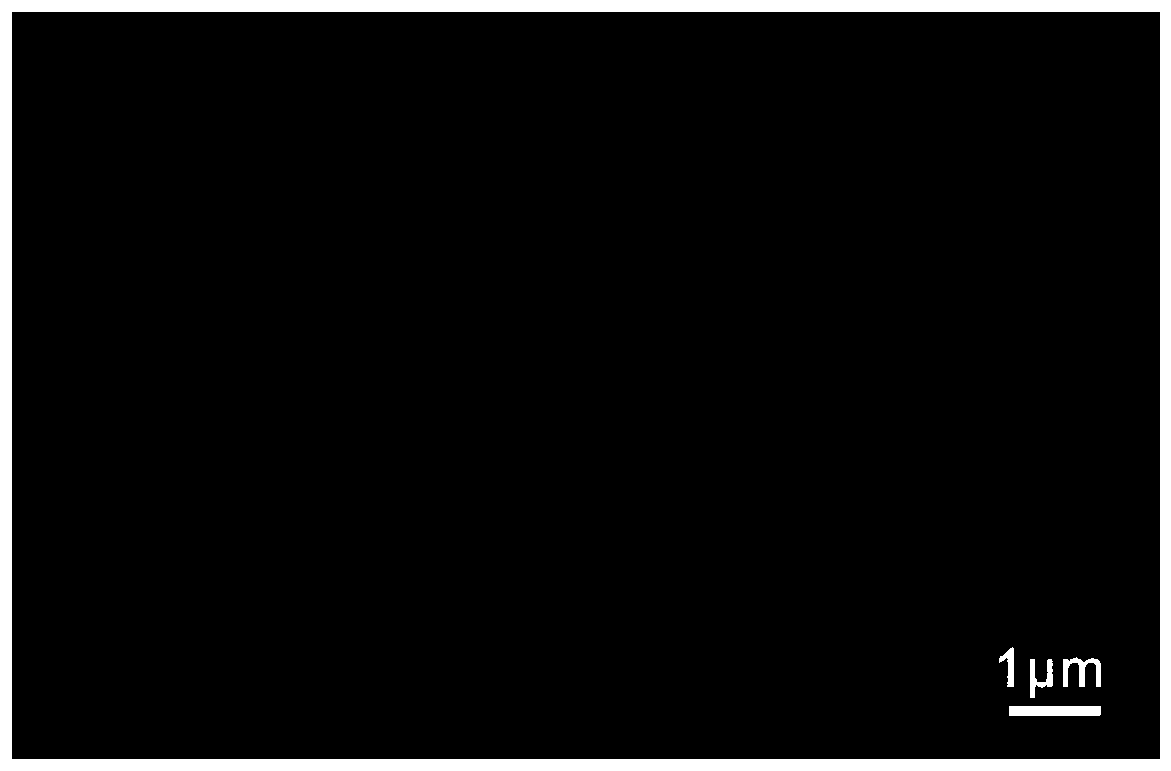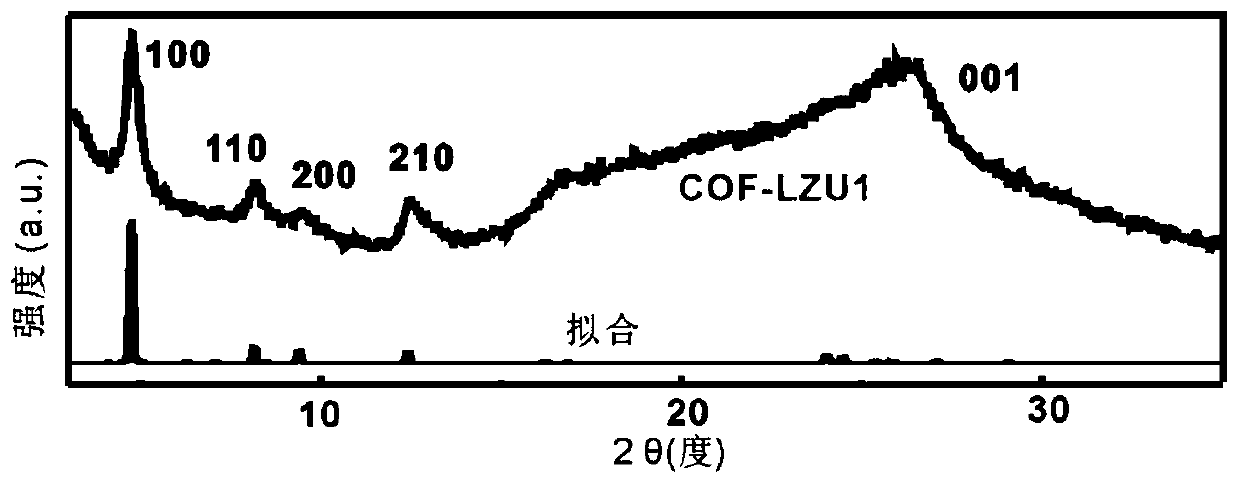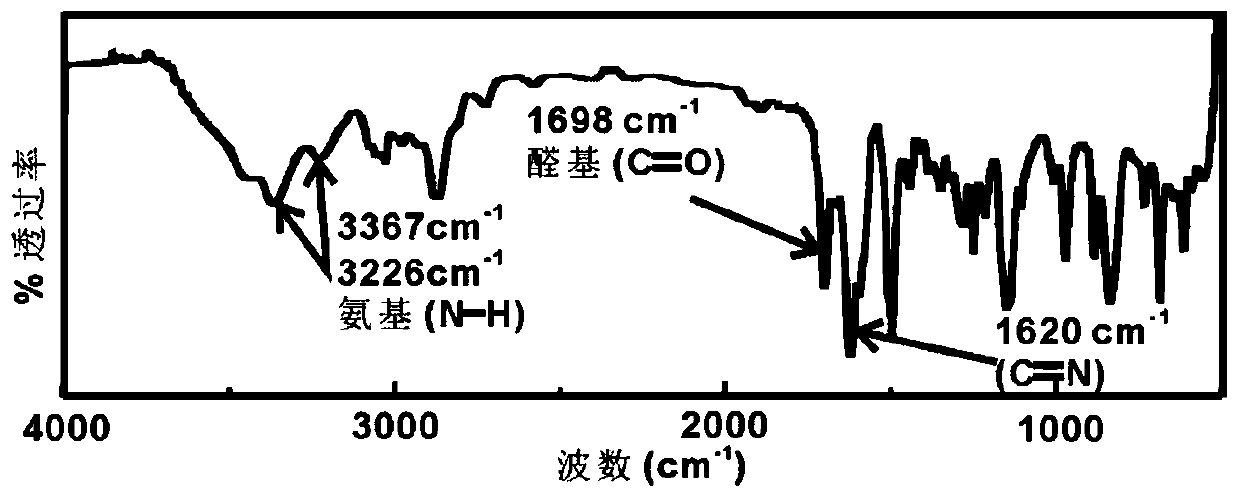Method of inhibiting growth of lithium dendrites through organic compound coating
An organic compound and lithium dendrite technology, which is applied in the field of organic compound coating to inhibit lithium dendrite growth, can solve problems such as dendrite growth, and achieve the effects of prolonging life, improving Coulomb efficiency and discharge capacity, and simple preparation method.
- Summary
- Abstract
- Description
- Claims
- Application Information
AI Technical Summary
Problems solved by technology
Method used
Image
Examples
Embodiment 1
[0044] A method for inhibiting lithium dendrite growth by coating with an organic compound, comprising the following steps:
[0045] (1) Preparation of organic compound COF-LZU1 rich in Lewis acidic functional groups and lithium-loving elements, the specific steps are as follows:
[0046] (a) 1.3 g of 1,3,5-triformylbenzene was dissolved in 80 ml of 1,4-dioxane, then 1.3 g of 1,4-phenylenediamine was added, and ultrasonically dissolved;
[0047](b) 16 milliliters of acetic acid solutions with a concentration of 3.0mol / L are slowly dripped into the mixed solution obtained in step (a), and then left to stand at room temperature for 72 hours;
[0048] (c) collecting the material obtained in step (b), washing it alternately with dimethylformamide and tetrahydrofuran, centrifuging, and finally drying in an oven at 60°C;
[0049] (2) Mix and grind the organic compound obtained in step (1) with a binding agent and an inert solvent; the ratio of the organic compound to the binding ag...
Embodiment 2
[0053] A method for inhibiting lithium dendrite growth by coating with an organic compound, comprising the following steps:
[0054] (1) Preparation of organic compound COF-LZU1 rich in Lewis acidic functional groups and lithium-loving elements, the specific steps are as follows:
[0055] (a) 1.3 g of 1,3,5-triformylbenzene was dissolved in 80 ml of 1,4-dioxane, then 1.3 g of 1,4-phenylenediamine was added, and ultrasonically dissolved;
[0056] (b) 16 milliliters of acetic acid solutions with a concentration of 3.0mol / L are slowly dripped into the mixed solution obtained in step (a), and then left to stand at room temperature for 72 hours;
[0057] (c) collecting the material obtained in step (b), washing it alternately with dimethylformamide and tetrahydrofuran, centrifuging, and finally drying in an oven at 60°C;
[0058] (2) Mix and grind the organic compound obtained in step (1) with a binding agent and an inert solvent; the ratio of the organic compound to the binding a...
Embodiment 3
[0062] A method for inhibiting lithium dendrite growth by coating with an organic compound, comprising the following steps:
[0063] (1) Preparation of organic compound COF-LZU1 rich in Lewis acidic functional groups and lithium-loving elements, the specific steps are as follows:
[0064] (a) 1.3 g of 1,3,5-triformylbenzene was dissolved in 80 ml of 1,4-dioxane, then 1.3 g of 1,4-phenylenediamine was added, and ultrasonically dissolved;
[0065] (b) 16 milliliters of acetic acid solutions with a concentration of 3.0mol / L are slowly dripped into the mixed solution obtained in step (a), and then left to stand at room temperature for 72 hours;
[0066] (c) collecting the material obtained in step (b), washing it alternately with dimethylformamide and tetrahydrofuran, centrifuging, and finally drying in an oven at 60°C;
[0067] (2) Mix and grind the organic compound obtained in step (1) with a binding agent and an inert solvent evenly, the ratio of the organic compound to the bi...
PUM
| Property | Measurement | Unit |
|---|---|---|
| Thickness | aaaaa | aaaaa |
| Thickness | aaaaa | aaaaa |
| Diameter | aaaaa | aaaaa |
Abstract
Description
Claims
Application Information
 Login to View More
Login to View More - R&D
- Intellectual Property
- Life Sciences
- Materials
- Tech Scout
- Unparalleled Data Quality
- Higher Quality Content
- 60% Fewer Hallucinations
Browse by: Latest US Patents, China's latest patents, Technical Efficacy Thesaurus, Application Domain, Technology Topic, Popular Technical Reports.
© 2025 PatSnap. All rights reserved.Legal|Privacy policy|Modern Slavery Act Transparency Statement|Sitemap|About US| Contact US: help@patsnap.com



